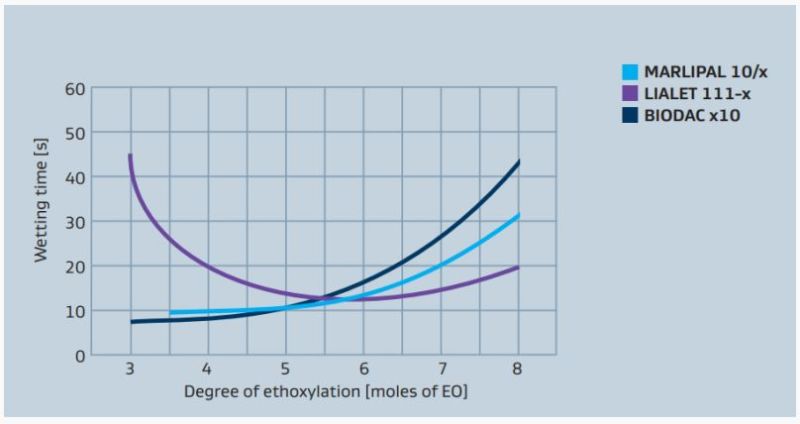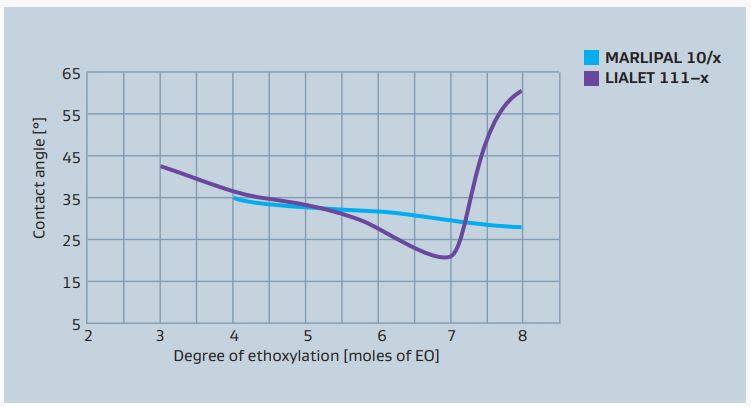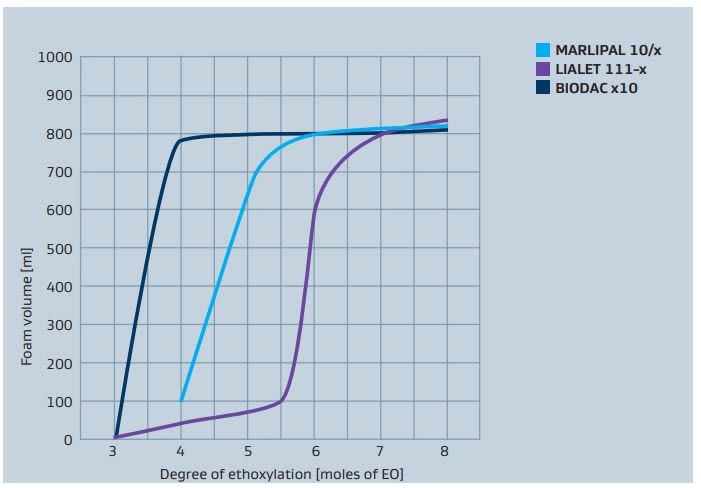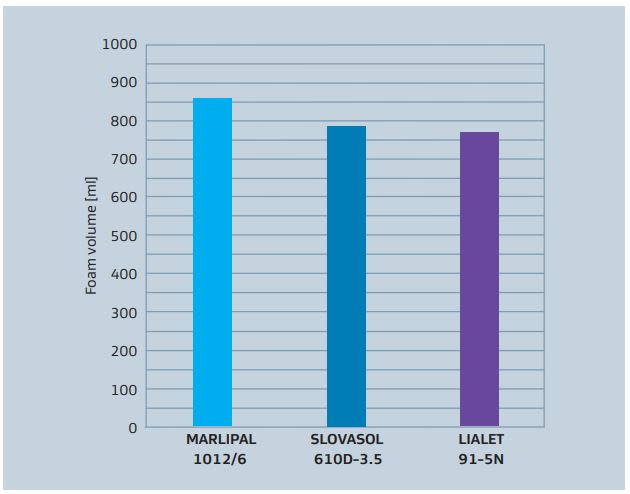Knowde Enhanced TDS
Identification & Functionality
- Chemical Family
- Chemical Name
- CASE Ingredients Functions
- Industrial Additives Functions
- CAS No.
- 26183-52-8
- EC No.
- 500-046-6
Features & Benefits
- CASE Ingredients Features
- Industrial Additives Features
Applications & Uses
- Markets
Properties
- Physical Form
- Odor
- Faint
- Appearance
- Clear liquid
- Emulsifiable in
- Water
- Partially Miscible In
- Water
- Typical Properties
- Solubility and Gel Formation With Water
Solubility in water
As for all alcohol ethoxylates the solubility of this product group mainly depends on the base alcohol and the length of the water soluble polyethylene glycol ether chain. Accordingly, the solubility increases with the degree of ethoxylation. Ethoxylates based on short chain alcohols with 3 to 5 moles of EO are only sparingly soluble in water whereas higher ethoxylated types are readily soluble in water and show excellent wetting properties.
Gel formation in water
Aqueous solutions of short chain alcohol ethoxylates cover a large range of viscosities from free flowing liquids to solid gels in dependence of the amount of water added. The gel phases typically occur at medium concentrations and can have significant stability even when additional water is added.
Overview of the gel formation of the different alcohol ethoxylates.
Product Name 0% water 10% water 20% water 30% water 40% water 50% water 60% water 70% water 80% water 90% water MARLIPAL 10/4 Cloudy Liquid Transparent Liquid Cloudy Liquid Gel or paste Gel or paste Gel or paste Gel or paste Cloudy Liquid Cloudy Liquid Cloudy Liquid MARLIPAL 10/8 Cloudy Liquid Transparent Liquid Transparent Liquid Transparent Liquid Cloudy Liquid Cloudy Liquid Transparent Liquid Transparent Liquid Transparent Liquid Transparent Liquid MARLIPAL 1012/6 Cloudy Liquid Transparent Liquid Transparent Liquid Gel or paste Gel or paste Gel or paste Gel or paste Transparent Liquid Transparent Liquid Transparent Liquid - Surface Active Property
One of the most characteristic properties of surface active agents is their ability to reduce the surface tension of water. Ethoxylates based on short chain alcohols provide a typical surface tension reduction. Upon addition of ethoxylates, the water surface tension of 72 mN/m can be reduced to values below 30 mN/m
The Critical Micelle Concentration (CMC) is a further characteristic property of a surfactant. The CMC is the concentration at which single surfactant molecules start to build micellar aggregates. CMC values as well as surface tension data at 0.1 g/l resp. 1.0 g/l for the ethoxylates based on short chain alcohols are recorded
Product Name Surface tension in mN/m, at 25°C in D.I. water Surfactant concentration Critical micelle concentration (CMC) [g/l] 0.1 g/l 1.0 g/l MARLIPAL 10/4 30 26 0.16 MARLIPAL 10/8 44 31 0.54 MARLIPAL 1012/6 29 28 0.15
| Value | Units | Test Method / Conditions | |
| Cloud Point (5g + 25g 25% BDG solution) | 59-62 | °C | DIN EN 1890 |
| pH (10 % in fully demin. water) | 5-7 | - | DIN EN 1262 |
| Refractive Index n 20/D | approx. 1.45 | - | DGF C-IV 5 |
| PEG Content | max. 1.0 | % mass | Weibull |
| Hazen Color Number | max. 100 | - | DIN EN 1557 |
| Iodine Color Number | max. 1 | mg I/100 ml | DIN EN 1557 |
| Flash Point | approx. 150 | °C | DIN 51376 |
| Ignition Temperature | approx. 300 | °C | DIN 51794 |
| Molar mass | approx. 334 | g/mol | Calculated |
| Water Content | max. 0.15 | % mass | DIN EN 13267 |
| Refractive Index | approx. 1.45 | - | DGF C - IV 5 |
| Molar Mass | approx. 334 | g/mol | Calculated |
| Density at 20°C | approx. 0.95 | g/ml | DIN 51757 |
Regulatory & Compliance
Technical Details & Test Data
- Wetting Efficiency
Wetting efficiency on textiles
Wetting efficiency on textiles, Cotton disk method (DIN EN 1772), 1 g/l in D.I. water, 20 °C
The wetting efficiency on textiles is an important criterion for assessing the performance of a surfactant. The wetting times of the alcohol ethoxylates were determined in aqueous solutions on cotton fabrics. The wetting performance, which corresponds to the time taken for a cotton disk to sink in aqueous solution, is a function of the degree of ethoxylation. The shorter the sinking time, the better the wetting efficiency

Wetting efficiency on hard surfaces
The wetting performance on hard surfaces such as metal or plastics can be assessed by contact angle measurements. The contact angle indicates how far a droplet of a surfactant solution spreads on the given surface. The lower the contact angle the better the wetting efficiency on the surface. Hydrophobic surfaces like plastics are usually more difficult to wet with water than hydrophilic surfaces. Ethoxylates based on short chain alcohols show an excellent reduction of the surface angles on hard surfaces compared to pure water.
Contact angles of ethoxylates based on short chain alcohols on steel after a spreading time of 9s on hard surfaces

Contact angles of ethoxylates based on short chain alcohols on plastics after a spreading time of 9s on hard surfaces.

- Foaming Profile
Ethoxylates based on short chain alcohols are moderate to high foaming surfactants. Figure 4 shows the foaming profile of MARLIPAL 10, BIODAC x10 and LIALET 111 ethoxylates. At room temperature the foam level of the ethoxylates increases with increasing degree of ethoxylation. The foaming behavior is determined by the SITA foam method (foam generated by a rotating disk).
Foaming profile SITA foam method, 1 g/l in D.I. water, 20°C

Foaming profile SITA foam method, 1 g/l in D.I. water, 20°C

Packaging & Availability
- Packaging Type
- Packaging Information
Road tankers, drums about 200 Kg, containers about 950 Kg
Storage & Handling
- Storage and Handling
Precautions for safe handling
Advice on safe handling
- Wear personal protective equipment.
- Avoid contact with skin and eyes.
Advice on protection against fire and explosion
- Normal measures for preventive fire protection.
- Do not spray on a naked flame or any incandescent material.
Fire-fighting class
- B: Fires involving liquids or liquid containing substances.
- Also includes substances which become liquid at elevated temperatures.
Conditions for safe storage, including any incompatibilities
Requirements for storage areas and containers
- Keep tightly closed in a dry and cool place.
Storage class (TRGS 510)
- 10-13: German Storage Class 10 to 13
Other data
- Stable at normal ambient temperature and pressure.
- Stainless steel (Steel No. 1.4541 or 1.4571).